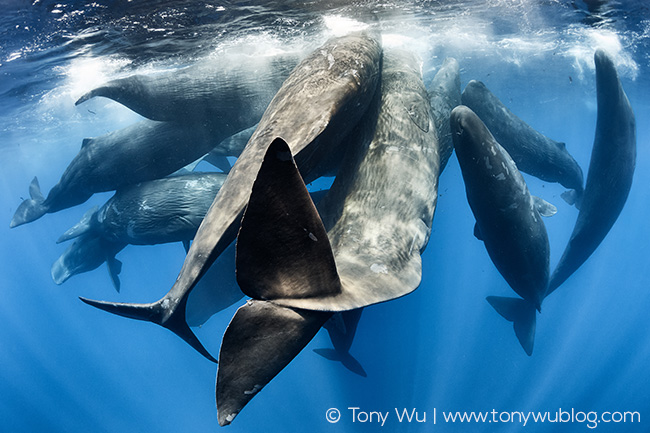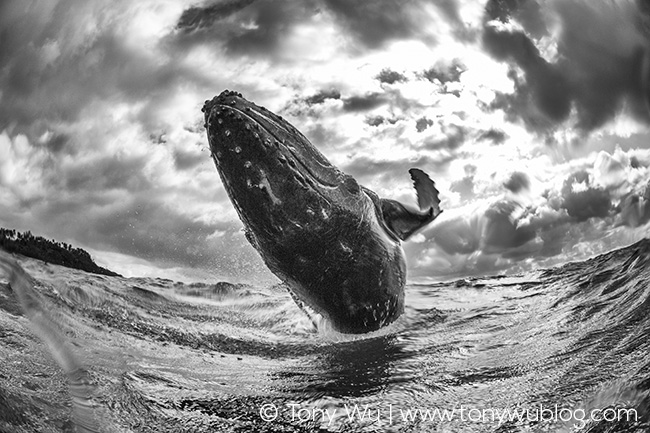In a little over a week, I’ll be in Hong Kong for the DRT Show.
I’m scheduled to give a couple of talks, one each about humpback whales (Megaptera novaeangliae) and sperm whales (Physeter macrocephalus), two species that I’ve spent many, many hours with.
Here’s the schedule:
- Talk 1: Humpback Whales on 12 December, 4:10pm
- Talk 2: Sperm Whales on 13 December, 4:00pm
Since getting back from Kyoto, I’ve been pondering how best to make use of the 40 minutes that the event organisers have allotted for each talk.
To start, I’ll be showing and talking about some images for the first time in public, ones like this photo of a sperm whale party:

And this picture of a baby humpback whale breaching:

But doing talks, for me at least, should be about more than just showing a bunch of photos. There needs to be a narrative, sharing of information and experience beyond just saying, “Hey, doncha’ think this photo is cool?”
There needs to be a reason for people to attend, and I would like for everyone who makes time in their schedules to walk away thinking: “Wow, I learned a lot. He’s not (quite) as clueless as he looks.”
Hours of pondering, enhanced by meticulously timed infusions of caffeine in various forms (coffee, pu-erh tea, green tea), has led me to decide to try something different…to make the two talks one.
35 minutes or so is far too short to convey more than a cursory introduction to either species, so trying to cram as much as possible about humpback whales into 35 minutes, for instance, would be frustrating for me and probably not entirely satisfying for people watching and listening.
But…if I create an hour+ presentation, 35 minutes or so devoted to humpbacks and the same to sperm whales, and give the entire talk over two days, I can convey some key points about each type of cetacean, but more interestingly perhaps, compare and contrast the two.
“Huh?” you might wonder. “Why would you do such a convoluted thing? You want me to listen to you twice?!!!!”
Well, humpbacks and sperm whales are representative of the two types of large cetaceans: baleen whales and toothed whales.
In other words, a whale is not just a whale. The term whale is a generic one that encompasses several dozen species (if you count the smaller cetaceans as well).
Though we refer to both humpbacks and sperms as whales, they are actually quite different in many respects—habitats, food sources, social structure, and so on.
The trick to pulling this off, of course, is that I need to make each talk self-contained, so that if you listen to me spiel about humpbacks on Saturday and decide that you couldn’t possibly put yourself through another of my talks, then you will have at least learned something about one species.
But if you do attend both days, I’ll be drawing comparisons and contrasts when I wrap up the second talk, so hopefully, you’ll walk away with an appreciation of two entirely different strategies and solutions for life as a large mammal in the big blue.
Sounds good, I hope?
A couple of asides:
Upcoming Trips: I’ve been communicating with everyone who expressed interest in joining me for trips next year. Some friends have had to change plans, as life unfortunately interferes with important things like having fun more often than should happen. My goal is to have a clear idea of trip openings by next week, so if you’re interested in joining me for a first-hand cetacean encounter, let me know via my contact form, or we can chat in person at the show.
WPOTY People's Choice Award: One of my sperm whale photos is up at the WPOTY contest site among the pictures selected for the People’s Choice Award. Please click through to take a look at my image and the other selected photos. There are a bunch of great photos. Vote for one that you like. It doesn’t have to be mine, though I’ll certainly appreciate your support if you do choose my image.
Ok that’s it. Now all I have to do is create the presentations…